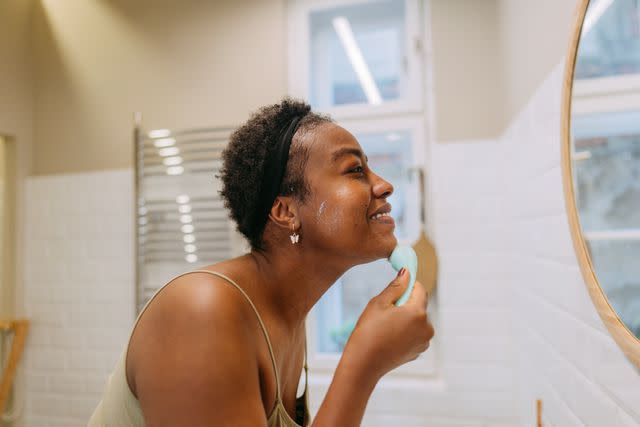Acne-Prone Skin: Extra Steps to Add to Your Skin-Care Routine
Medically reviewed by Susan Bard, MD
Acne-prone skin is a common condition that includes several different skin types. People with acne-prone skin are more likely to experience acne. It is caused by overactive oil glands that lead to a buildup of oil, dead skin cells, and bacteria in the skin pores. This leads to redness and swelling in the pores.
There are several possible causes of acne-prone skin. Fortunately, acne is treatable and can sometimes even be prevented. This article will provide an overview of acne-prone skin, including the triggers, treatment options, and self-care strategies.

AleksandarNakic / Getty Images
First Things First: Defining Acne-Prone Skin
Acne-prone skin is skin that is more likely to become inflamed and irritated. Acne can be triggered by various factors, including hormonal changes, stress, sweat, humidity, medications, and oily skin or hair products. Acne most often occurs on the face, neck, upper trunk, and upper arms.
Acne comes in many forms, including:
Whiteheads: A closed skin pore that is plugged with oil, dirt, or bacteria but not inflamed
Blackheads: An open skin pore that is plugged with oil, dirt, or bacteria but not inflamed
Papules: Small, red, inflamed bumps (pimples or pustules)
Nodules: Inflamed, large, hard lesions deeper under the skin
Cysts: Fluid-filled inflamed lesions under the skin
Where Acne Appears
Acne can occur anywhere on the body. It is possible to have acne-prone skin without experiencing breakouts on your face.
Learn More: Back and Body Acne Causes and Treatments
Why Do Some People Have Acne-Prone Skin?
People with acne-prone skin usually have overactive oil glands in the skin, leading to an excessive amount of oil. This excess oil can easily clog the pores, leading to breakouts. Research shows that people who are prone to oily skin are more likely to experience acne.
Some possible causes of oily skin include hormone fluctuations, certain medications, and regularly using oily skin or hair products. There is not enough evidence to suggest that your diet leads to oily skin.
Skin-Care Routine for Acne-Prone Skin
Skin care for acne-prone skin usually involves different strategies for controlling the amount of oil on the skin. You can reduce your risk of breakouts by reducing the amount of oil, dirt, dead skin cells, and bacteria on the skin.
If you have acne-prone skin, consider implementing the following strategies:
Wash your skin once or twice daily.
Wash your skin after exercising, sweating, or working with greasy foods.
If your hair tends to be oily, shampoo it every day.
Try to keep your hair off of your face.
Use skin products that are not oily. They will be labeled “noncomedogenic” or “non-acnegenic.”
Use a gentle moisturizer once daily.
Wear light sunscreen when spending time outdoors.
Consider using blotting papers throughout the day to soak up excess oil.
What to Avoid With Acne-Prone Skin
Several common habits can make your skin more prone to acne. The following tips may lower your risk of experiencing acne:
Do not wash your skin several times per day. Washing too much can damage and dry out the skin, leading to irritation.
Avoid scrubbing your skin when washing. Instead, use a gentle circular motion with your fingers.
Avoid oily hair or skin products. Do not use harsh products like rubbing alcohol on your skin.
Do not wear tight clothing if you are prone to body acne.
Never pop or squeeze a pimple because this can cause infected tissue to get pushed deeper into the skin, leading to more inflammation and possibly scarring.
Do not sleep in your makeup. Try to wash your face before going to bed.
Try to avoid touching your face throughout the day.
Do not switch your acne treatments often. Many treatments take six to eight weeks to start working.
Avoid sharing any products or tools you use on your face, including makeup and makeup brushes.
Dermatologist Treatment
Fortunately, acne-prone skin is treatable. Several options are available, either over-the-counter (OTC) or with a prescription.
OTC acne treatment options include products with the following components:
Salicylic acid: Reduces skin inflammation and helps to unclog the pores
Benzoyl peroxide: Considered the most effective OTC ingredient because it kills bacteria that lead to acne
Retinoids: Exfoliate the skin’s surface and remove dead skin cells that can clog the pores
If OTC treatments have not helped, call your healthcare provider. A dermatologist (a medical doctor specializing in diagnosing and treating skin disorders) treats acne with medications and in-clinic procedures.
Prescription options for treating acne include:
Antibiotics: Topical antibiotics (applied to the skin) can treat bacteria that may cause acne.
Hormonal medications: These medications can treat acne if your skin tends to break out with hormonal changes.
Isotretinoin: This prescription medication is used only for severe acne.
Photodynamic therapy: Light therapy can help to clear up and prevent acne.
Chemical peel: Chemical skin peeling removes dead skin cells that can build up and clog the pores.
Related: Oral Acne Medication Options
Summary
People with acne-prone skin are more likely to experience acne. Acne may look like whiteheads, blackheads, papules, nodules, and cysts. Acne occurs when the skin pores become clogged with oil, dirt, dead skin cells, or bacteria. This leads to redness and swelling of the skin.
People with acne-prone skin tend to have oily skin. Strategies to reduce the number and severity of acne breakouts include washing your face with a gentle cleaner once or twice daily, wearing light sunscreen when spending time outdoors, and avoiding oily hair or skin products.
Acne is a treatable condition with over-the-counter remedies or dermatologist treatments. See your healthcare provider for an individualized treatment plan.
Read the original article on Verywell Health.

